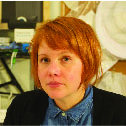

Many studio art traditions, including the fields of textile design and garment-making, have traditionally been spaces with reified gender associations, for example, abetting mobility and function for men and passivity and ornamentation for women. Yet the students encountering these traditions today are increasingly interested in non-binary and gender-fluid approaches.
The Gender-Neutral Fibers Initiative supports exploration of materials, techniques, gender, and identity in self-directed ways. Students, primarily from art and design, but also from engineering and other fields, are encouraged to experiment and bring in other disciplinary interests as they develop the knowledge and skills required to work with fibers. Carefully crafted assignments, paired with readings and discussion, give both majors and non-majors the option of investigating issues of identity and gender during creative expression. The approach is not prescriptive since assignment goals can be completed without addressing gender. Instead, the classroom environment feels inclusive, and students can choose how much or whether to connect their identities to the topics at hand.
The approach can be used in other disciplines that also struggle with gender disparities, from architecture to mathematics. The initiative provides a model for beginning a process of examining gendered histories of any given field, as well as integrating non-binary and gender issues into coursework to challenge longstanding disciplinary perceptions.
Student Comments
Questions, readings, class discussions, and one-to-one conversations have helped me to redefine and challenge gendered histories in fibers and in my other coursework.
Open conversations through the Gender-Neutral Fibers Initiative made gender imbalances in the industry more apparent to me, as well as insights into historical conventions of gender and the politics of male, female, and nonbinary perspectives.
I became more aware of my male lens and also, I hope, learned to transcend this view and to wield textiles in ways that communicate my own voice.
I have gone through the process of learning and understanding the complexities of identities, while also gaining the ability to tell my own story through a feminist lens.
My garments challenge gender by creating for people who identify in between the binary. I have learned to custom-fit all sizes and bodies, male, female, or non-binary; and have built in adjustable modules for flexibility. For example, one design has reversible and detachable long sleeves and pants.
I am currently exploring the politics of my Japanese-German heritage, and how race and discrimination factor into our nation’s policies around entry and access to American rights. My work references the 1942 displacement of thousands of Japanese citizens in internment camps as a lens to similar racial politics within the current political administration.




